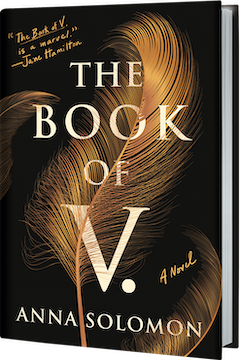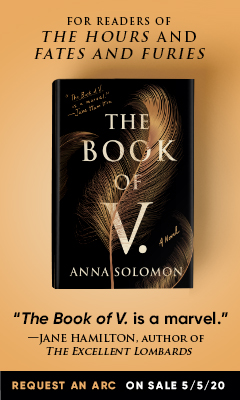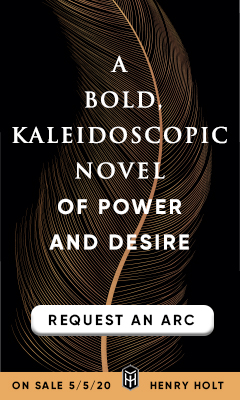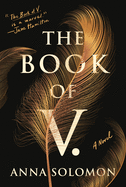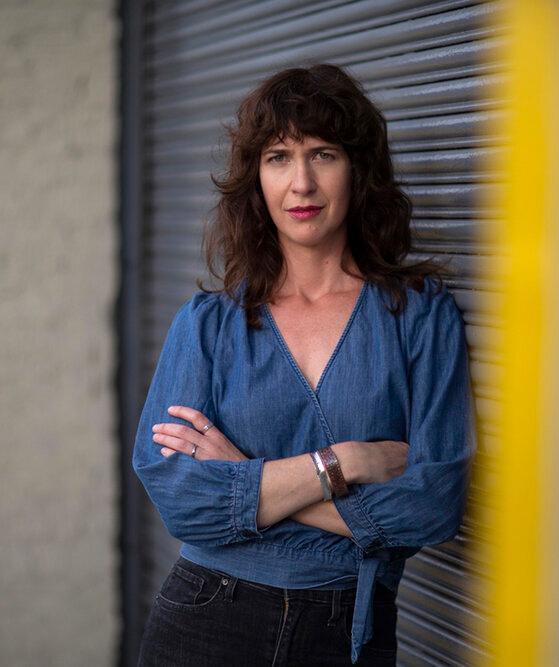The Book of V.
by Anna Solomon
The Book of V. by Pushcart Prize-winner Anna Solomon (The Little Bride; Leaving Lucy Pear) explores the lives of three women, apparently unconnected yet increasingly intertwined as the pages turn. The braided result is moving, surprising, so touchingly detailed and authentic as to seem more real than life.
In biblical times, a king of Persia takes a second wife. Solomon's epigraph comes from Elizabeth Cady Stanton's The Woman's Bible: "I have always regretted that the historian allowed Vashti to drop out of sight so suddenly." This first wife simply disappeared: "No one knows. She's gone." Solomon takes steps to correct the oversight of Vashti, but she is more concerned with the second wife--Esther, a Jewish orphan girl, chosen by the king as his replacement queen against her wishes.
Esther, meant to be homely and invisible, tried to shrink from the spotlight but somehow charmed the king despite herself. She casts a long shadow here, telling her own story--how she resisted the role of queen, and later used it to save her people--and then influencing several lives that come later.
Lily and her family live in Brooklyn in 2016. Lily gave up her academic career to stay home with her children: two girls who keep asking her to read the Esther book to them, even though she is thoroughly sick of it. Her husband works as deputy director of programs for Rwanda at a major humanitarian aid organization. It's not that Lily misses academia, but she's a little dissatisfied with the life she traded it in for. She is also a second wife.
And then there is Vivian, wife of a senator from Rhode Island in the 1970s. Vee is the daughter of a senator's wife who was the daughter of a governor's wife. In D.C., she is torn between the women in her consciousness-raising group--"with their circle-talk and their red wine and unmade faces"--and the other senators' wives: "They are dazzling, these wives of politicians and company presidents, these tigresses who openly dislike and disagree with each other." Vee is a little of each--and a little contrarian, driven to thwart both.
The title, The Book of V., refers to Vee, to Vashti and surely, to a part of the female anatomy. "This is what the women's group women insist on calling it. Vagina, [Vee] thinks dutifully, though the word disgusts her." Solomon shows a careful attention to words. "A blowhard, Esther called him, perhaps not with that word but with another that meant the same in that time and place." Her writing is lovely, incandescent; paradoxically, it has that ability that fine writing often has to disappear into the background, so that readers seem to hear the characters directly without a writer's mediation at all.
Readers follow Esther as she is thrown into a pageant (in several senses of the word) against her will, by an uncle who hopes she will solve problems bigger than herself, problems that have been plaguing the Jewish camp outside the city walls. Vee challenges her husband's authority repeatedly, finally disobeying him in the same way that, legend has it, got Vashti banished or killed. Lily struggles with an attraction to another woman's husband, just as her mother takes ill.
Chapters alternate among the perspectives of these three women. Individually stunning, their stories also intersect and meet in unforeseen ways. Though each takes center stage in turn, it requires all three to form the complete picture. They illuminate each other. The women's relationships with men are very much at issue: Esther's unkind king and his more powerful minister; Lily's essentially good but somewhat boring husband; and Vee's rather sadistic senator. They are joined by other male characters, sex symbols and brothers and abusers. But relationships between women are privileged. The Bechdel test--the idea that a book (1) should have at least two women in it, who (2) who talk to each other, about (3) something besides a man--is easily passed. Esther, Lily and Vee are joined by many interesting women: one of the maidens forced alongside Esther to compete for the king's favor; Lily's inscrutable mother; an old friend of Vee's; a fellow Brooklyn mom who makes suspicious attempts to befriend Lily.
Each story is gripping in itself, and to balance them in alternation is a trick; it is to Solomon's credit that the reader moves so smoothly among them, always sorry to step away but eager to return to the next woman, so that the pages fly by with unusual momentum. For a novel to offer such delightfully realized characters as well as such taut pacing is a fine accomplishment. The interweaving of the women's lives is cleverly done, hinted at early on (as with references to Vee's senator as royalty, or Lily's daughters' interest in Esther) with a light hand, and then growing as past secrets come to light.
With tense, deft plotting, memorable characters and writing that glows with each sentence, The Book of V. is a striking effort that will leave readers long inhabiting the worlds of Vee, Lily and Esther. --Julia Kastner



